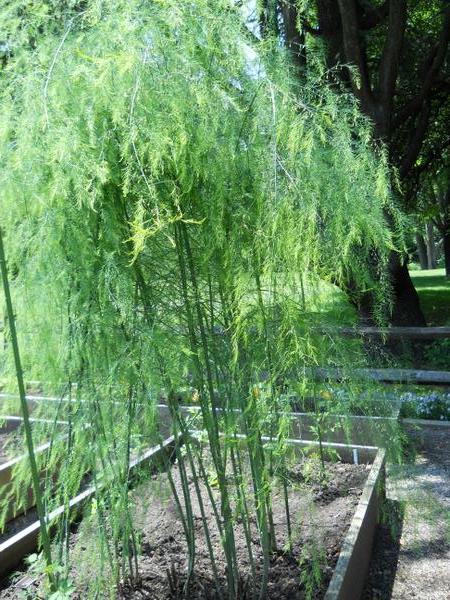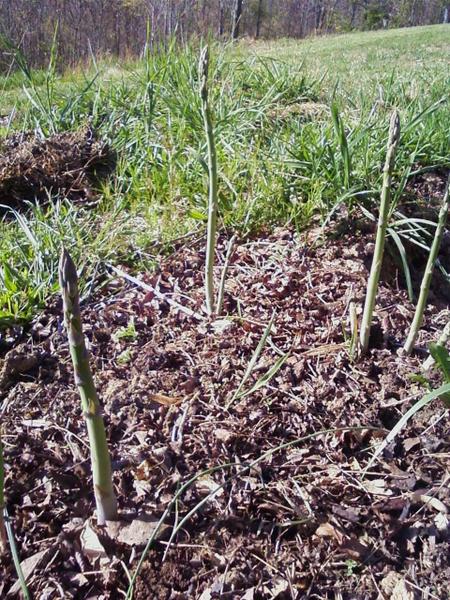Asparagus has been considered a spring garden delicacy since Roman times. Any home gardener can grow and enjoy this vegetable. Asparagus is a perennial. If you plant and manage it properly, it will produce for 15 years or more. Because this crop will occupy the land for many years, you should select the location and prepare the bed carefully. Location, soil type, soil fertility, size and age of crowns, and correct planting are important.
Varieties — Mary Washington (a rust-resistant variety) is a standard variety for most home gardeners. However, the all-male hybrids Jersey Gem (cercospora leaf-spot tolerant) and Jersey Knight produce significantly more yield. In addition, they produce no seed; thus, no weedy seedling asparagus. Atlas is another popular variety and has very large-diameter spears.
How Much to Plant — To produce enough asparagus for fresh table use, plant 10 crowns for each family member. If you are especially fond of asparagus or want a surplus to share, can, or freeze, plant at least 25 plants for each family member. If you use the new hybrids reduce the number of plants by half.
Soil and Soil Preparation — Choose a site in full sun and relatively free of perennial broadleaf weeds and nutgrass. Any well-drained soil will produce good asparagus but it does best in deep, fertile, sandy loam or loamy soil. If your soil is clay, you should condition it with peat moss, leaf mold, or straw so spears will emerge straight. Using a raised bed is especially helpful with heavy soils. Have a soil test made at least 6 months before planting. Take soil samples 12 inches deep. Follow the directions on the soil test report to amend the soil to achieve a soil pH between 6.0 to 6.7. Asparagus grows poorly in acid soils.
Start building up the organic matter (humus) content of the soil at least a year in advance of planting. This can be done by turning under green manure crops, composted animal manure, straw, peat moss, or leaf mold. Till the soil deeply several times before planting so that it will be in fine tilth at the time of planting. Use commercial fertilizer in addition to manures. Follow soil test suggestions.
Planting — Crowns (roots) should be planted in rows 5 ft apart with the crowns spaced 12 inches apart in the row. The distance between rows can be reduced, but this may shorten the life of the bed. Closer in-row spacing will increase yield. Use large, well-rooted, one-year-old, disease-free crowns, purchased from a reliable source. To grow your own crowns, drill seed in the spring 1⁄2 inch deep and 2 inches apart in rows 2 to 3 ft apart. Germination is hastened by soaking seed in water for 5 to 6 days before planting. Dig and transplant the crowns the following spring. One oz of seed produces about 700 crowns.
In eastern North Carolina, plant the crowns in February. In the Piedmont and Mountains, plant in late winter, after the danger of hard freezes is over, but before plant growth starts. Plant the crowns in a furrow 8 inches deep. Make the furrow wide enough to accommodate the root system of the crowns when fully spread out. In placing the crowns in the furrow or trench, be sure to have the buds pointing upward. Cover the crowns with 2 inches of soil. As the plants grow, pull soil around the plants gradually until the trench is filled.
Annual Care of the Bed — Cultivate when necessary to control grass and weeds to ensure a good crop of large spears. During the harvest period, asparagus can withstand shallow cultivation. Use mulch to suppress weeds and if necessary follow the weed management directions in the NC Extension Gardener Handbook.
Each spring, just before the spears start to grow, broadcast a complete fertilizer such as 5-10-10 on the bed at the rate of 2 to 5 lb per 100 ft2. This should be done about March 1 for the east and 2 weeks later for the rest of the state. Give the bed a second application of fertilizer at the end of the cutting season.
Allow the plants to grow in the fall until they have turned brown. Then cut down the fern and destroy it. If cut down before frost, the next year’s crop of spears is reduced.
Harvesting — Do not harvest asparagus the first growing season after planting crowns. It can be harvested (cut) for a short time (not to exceed two weeks) the second year. Weak plants and small spears result from harvesting too much, too early. After the second year after planting crowns, harvest asparagus from 6 to 8 weeks each year. Weak plants should be harvested for less time.
Exercise care in cutting the spears to prevent damage to those spears that have not yet emerged. Cut or snap the spears at ground level. This practice eliminates the possibility of damaging other spears.
Preparation for Use — Fiber develops rapidly after Asparagus harvest making the spears less edible. To maintain asparagus quality, wash and cool asparagus soon after harvest. If the asparagus wilts, it can be made turgid by soaking in cool water.
For more information on growing, harvesting, and storing asparagus as well as recipes see Asparagus Grow It, Eat It.
| Time of Year | Year | Activity |
| Spring | 1 | Plant seed for crowns. |
| Spring | 2 | Dig crowns and plant in permanent site. |
| Spring | 3 | Harvest lightly (2 to 3 weeks). |
| Spring | 4 to 15 | Harvest 6 to 8 weeks each spring. |
Publication date: Jan. 31, 2001
Reviewed/Revised: Oct. 6, 2019
N.C. Cooperative Extension prohibits discrimination and harassment regardless of age, color, disability, family and marital status, gender identity, national origin, political beliefs, race, religion, sex (including pregnancy), sexual orientation and veteran status.


